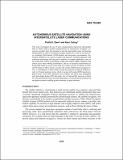Autonomous satellite navigation using intersatellite laser communications
Author(s)
Davé, Pratik K. (Pratik Kamlesh); Cahoy, Kerri
DownloadAccepted version (1.468Mb)
Open Access Policy
Open Access Policy
Creative Commons Attribution-Noncommercial-Share Alike
Terms of use
Metadata
Show full item recordAbstract
© 2020, Univelt Inc. All rights reserved. This work investigates the use of laser communication (lasercom) intersatellite links to obtain relative position measurements for autonomous navigation. Lasercom crosslinks have the potential to provide intersatellite range and bearing measurements in order to accurately navigate satellites in a wide set of orbit cases, including GNSS-denied, GNSS-limited, and deep-space environments. Numerical simulations are used to compare the lasercom crosslink approach with traditional positioning and navigation methods in example application cases in low Earth-orbit (LEO), geostationary Earth-orbit (GEO), highly elliptical orbit (HEO), and a Mars-orbiting constellation. The use of lasercom measurements in Earth-orbit results in errors on the order of 2 meters in LEO, 10 meters in GEO, and 50 meters in HEO, which is on-par with current GNSS-based navigation errors. A constellation of Mars-orbiters using the proposed navigation method results in 10-meter position errors, which is on-par with current DSN-based navigation errors, when DSN operations are available, and better than propagated state knowledge during DSN data gaps. Use of intersatellite lasercom systems for orbit determination also decreases dependence on ground-based tracking and navigation systems, enabling greater autonomy in space missions.
Date issued
2020Department
Massachusetts Institute of Technology. Department of Aeronautics and AstronauticsJournal
Advances in the Astronautical Sciences
Citation
Davé, PK and Cahoy, K. 2020. "Autonomous satellite navigation using intersatellite laser communications." Advances in the Astronautical Sciences, 171.
Version: Original manuscript